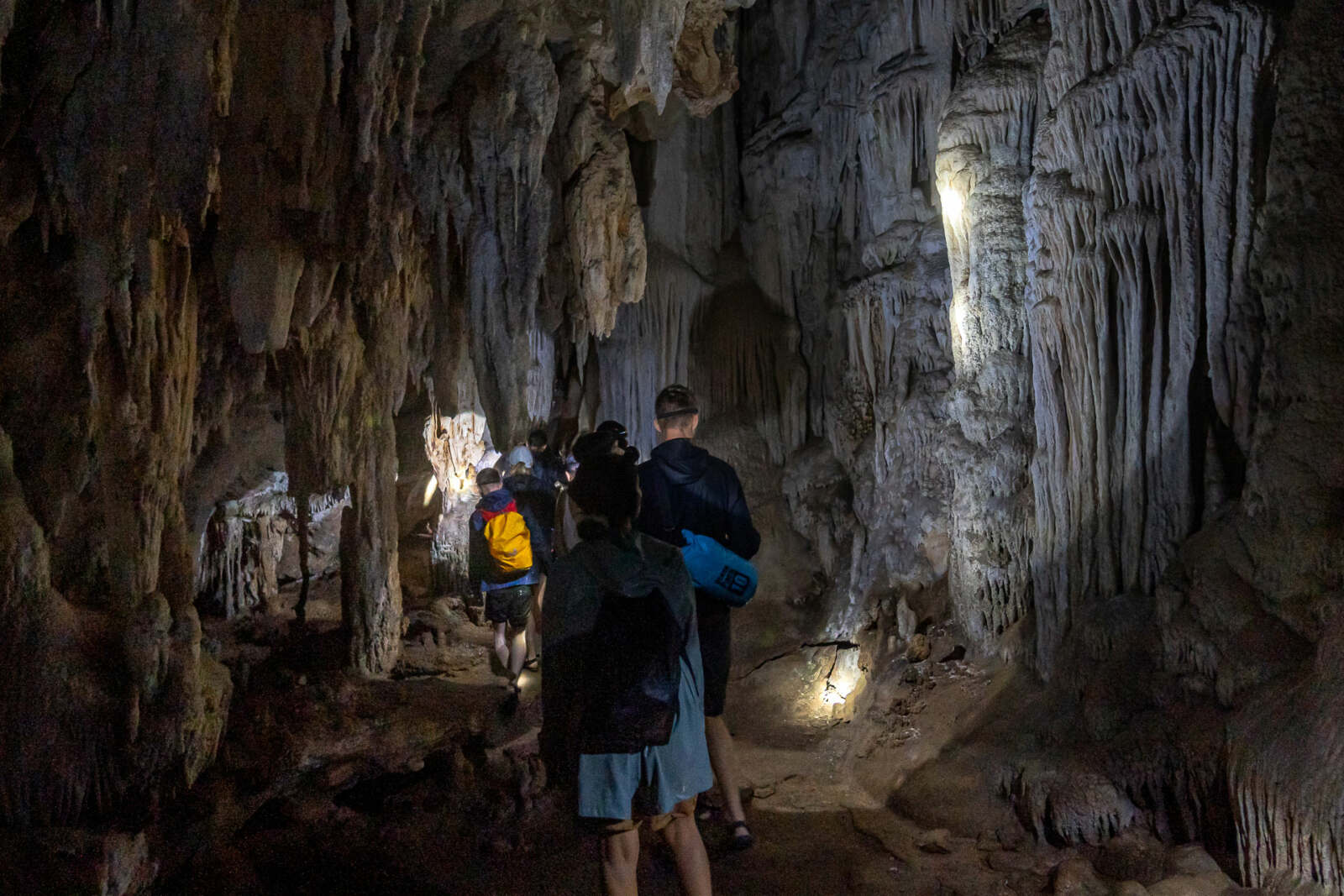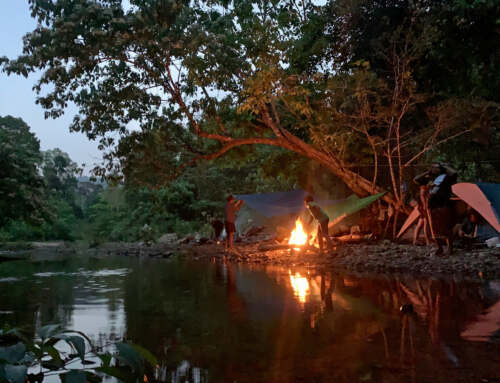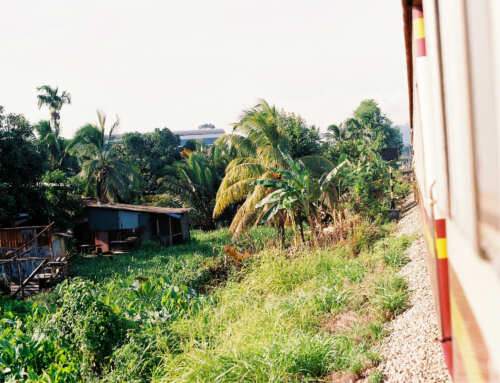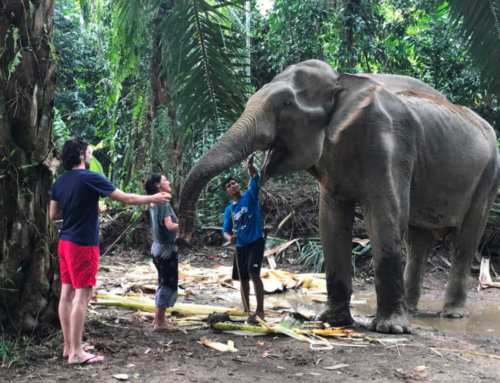This blog chronicles the experience of my first hike into this magical region in search of an amazing Khao Sok cave. There are many caves in the area as a result of the limestone geology. However, Tam Gaew is the only one that features an amazing crystal chamber. Hence its name in Thai, Tam Gaew. It is outside the technical boundaries of Khao Sok National Park, but it might as well be inside. We drove about 30 minutes from Khao Sok village to the trailhead. The hike to the cave is about 45 minutes, depending on fitness levels and how frequently you stop to look at the cool things you find along the way.
Disclaimer: I am a geologist, or at least I aspire to be. Tam Gaew is particularly interesting due to its unusual variety, and quality, of speleothems. A speleothem is scientifically defined as “a weird rock formation that grows in a cave”. This is the first cave I have ever seen helictites in. They boggled my mind, defying any ability to imagine how they might have formed.
Khao Sok cave – Hike to Tam Gaew
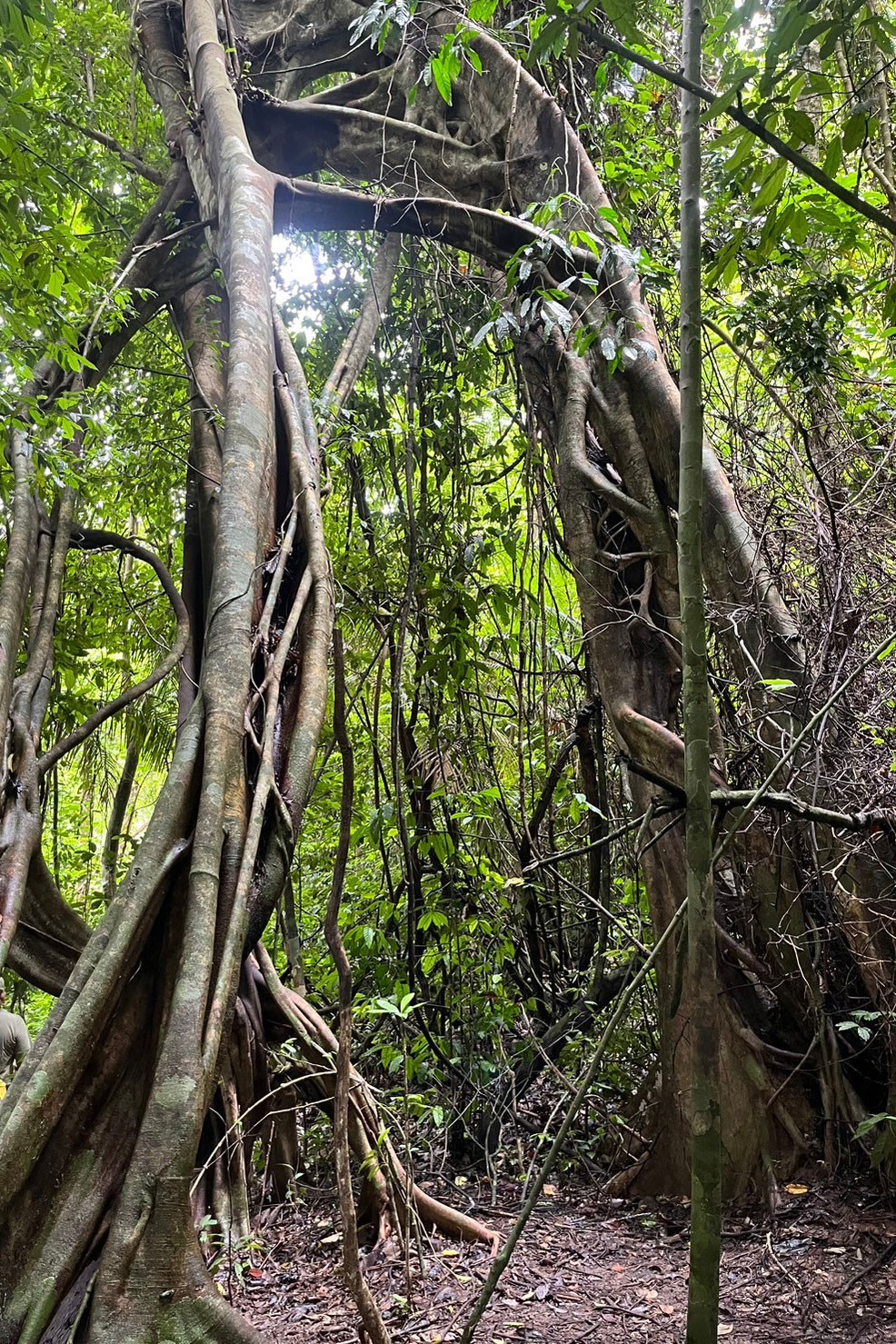
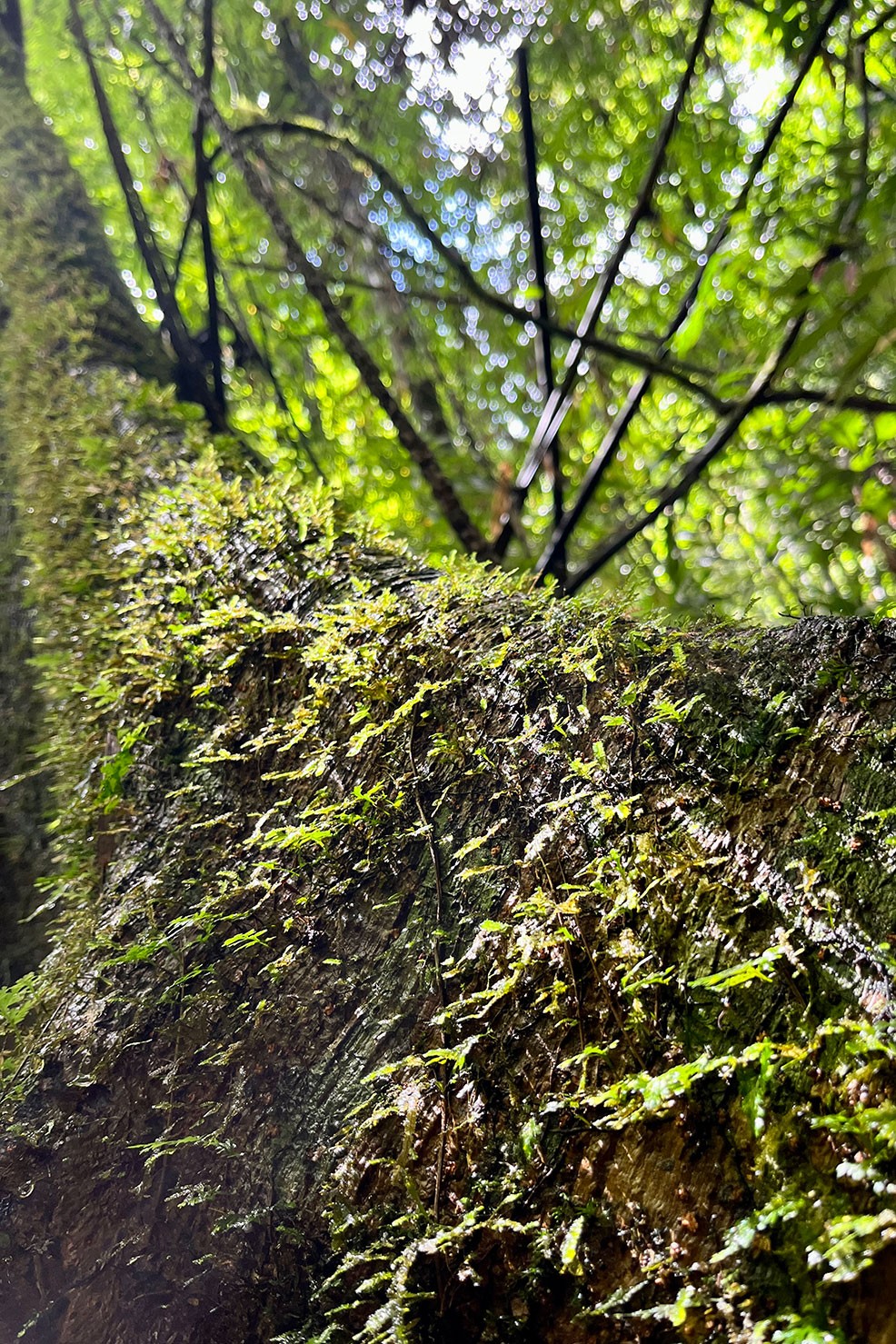
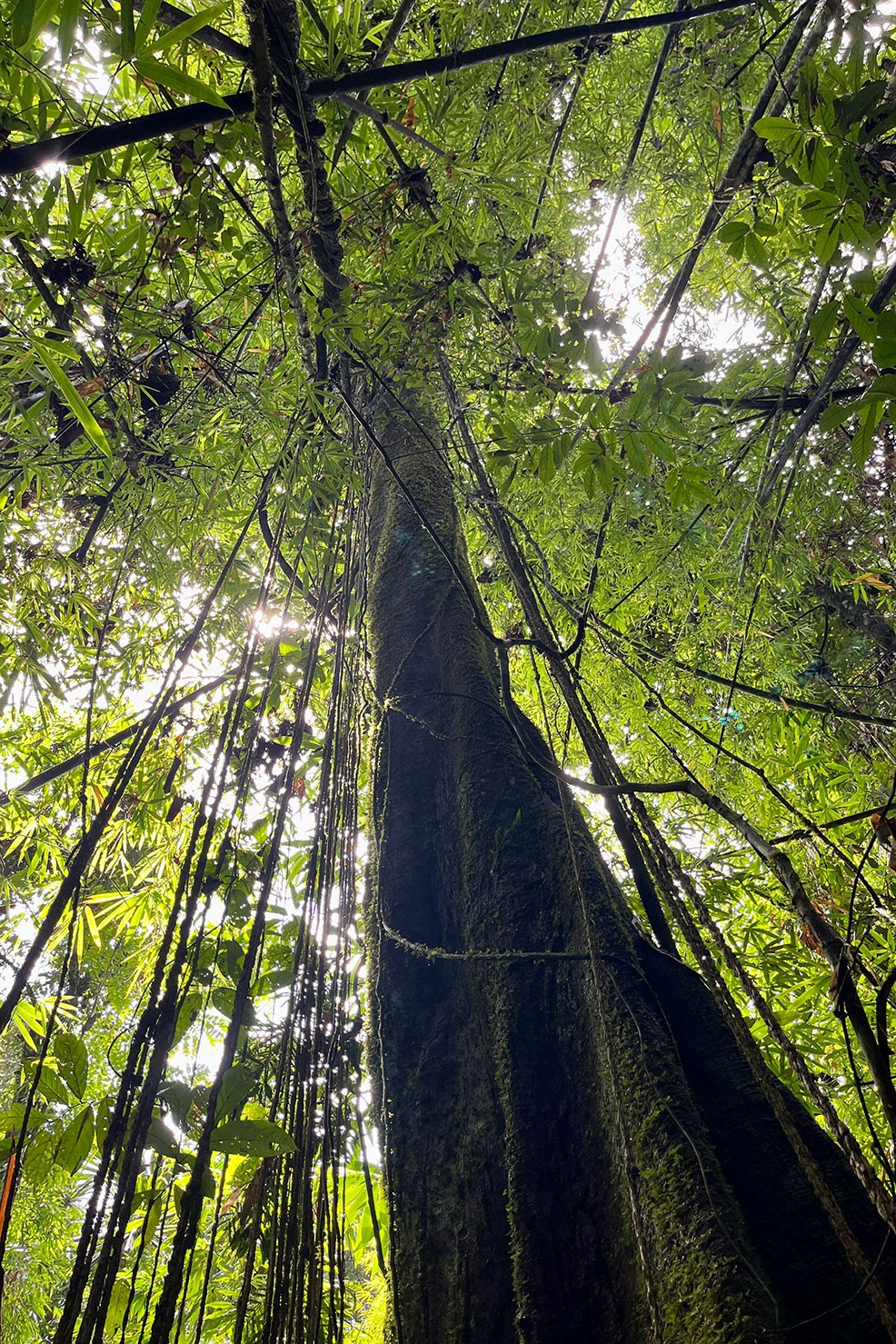
We entered the jungle on a paved pathway that winds through a couple of small caves inhabited by Buddhas. Eager for cave discoveries, my eyes interpreted the gold leaf littering the ground in these caves as mica or something akin to fool’s gold.
The cave tunnel exits toward the river to the west. We see woody hanging vines on our right and fluorescent colored lichen on the limestone wall to our left. We were hiking during the region’s dry season, so the trail was drowned in leaf debris from the deciduous plants shedding onto the path. I was then struck by perfectly vertical hanging vines on my left. Most of the vines that I have seen in the jungle thus far wind their way through the air or at least fall to the ground in curving and crooked manners. These vines draw a perfect line, a 180˚ angle, from somewhere in the limestone protrusions up above down to the sediment and debris trailside.
Giant Choke Palms
Each glance around the path took my breath away anew with the discovery of never-before-seen examples of Nature’s marvelousness. While negotiating over large tree roots, I looked up and discovered that these roots are from the GIANT palms growing along the trail. These are called Choke Palm, and the size of the fronds is breathtaking. Under some of these palms, I found the desiccated seed pods of the Choke Palm’s strands of grape-like clustered seeds. These piles are evocative of the pecan shells often used as a grass or gravel alternative in landscaping. After looking back down, I realized that the floor of the trail was painted with a dozen shades of green, each shade corresponding to a different biota feeding off of the rocks and ground.
The path, scattered with downed rocks, moved uphill to a gazebo structure. Stopping at the gazebo and looking in a southwest direction, I saw the shimmering river below and the terraced hill of a tea plantation next to a tree farm above the jungle foliage. To the right (to the north), I was taken aback by the majestic enormity of Khao Sok’s famous karsts.
Observing a giant boulder
The trail then seamlessly led us deeper into the dense foliage of the jungle. Somewhere down the wandering trail a huge boulder formed a trail boundary on the right. The boulder was striking in its dark color with a green tint (again from biotic residents). It was such a large chunk of rock that I had to stop and stare at the cliff above to see if I could pinpoint the spot from which it fell. After identifying a likely possibility, I spied a tree-boulder almost hidden by the boulders closer to the trail on the right. This sight was remarkable: the tree seemed to cover the entire top surface of the boulder – an impressively large surface – and the transition from boulder to tree is almost seamless.
After trudging through the bouldered hallway, the trail became more wooded. Peeking through the carpet of leaves, I could see streaks of dark red sediment. My eyes followed the colorful paint strokes to very distinct red oxidized iron streaks of red (probably iron-rich rock) in the limestone wall on my left.
The climb up to the cave
As with most hikes in search of a Khao Sok cave, the trail became steeper and the hiking became more adventurous. I needed the aid of a rope affixed alongside the trail as I climbed up alongside the massive karst face. Halfway up, I made the incredibly rewarding decision to pause and look back. Vistas of karsts cloaked in mist peered through the jungle canopy.
The trail then topped out with an impressive view of the limestone face on your left. Nature struck me yet again with the massive volume of limestone protrusions dripping from the side of the wall. My favorite (and probably the most immediately noticeable) somewhat resembles the head of an elephant capped with a green pointed headdress (made of green vines).
After passing the elephant head, the roof, created by the canopy above, suddenly lifts and more vertical space is revealed. I did not realize what a tunnel the jungle had created around me thus far until the vertical space above my head tripled and the feeling was similar to walking into a grand ballroom or cathedral.
Arriving at the cave
Soon after, the canopy opened up completely. The last bit of trail led through a field of dark green low viney leafy plants. The feeling was similar to walking through a field of short wildflowers or thick grasses. The entrance to our Khao Sok cave is guarded by a green field comprising of a minefield of tripping mechanisms. Their vines, although small and seemingly insignificant, inevitably caught my feet time and again to remind me of the appropriate humility in the face of nature. Apparently, I needed additional reminders on the way back, because the slippery rocks shifted beneath my feet and only broke my fall with their jagged points under my derriere. The scabs and bruising on my tailbone surprisingly served as delightful long-term reminders of the awe and magic that I experienced on that hike :)
Tam Gaew – The crystal chamber
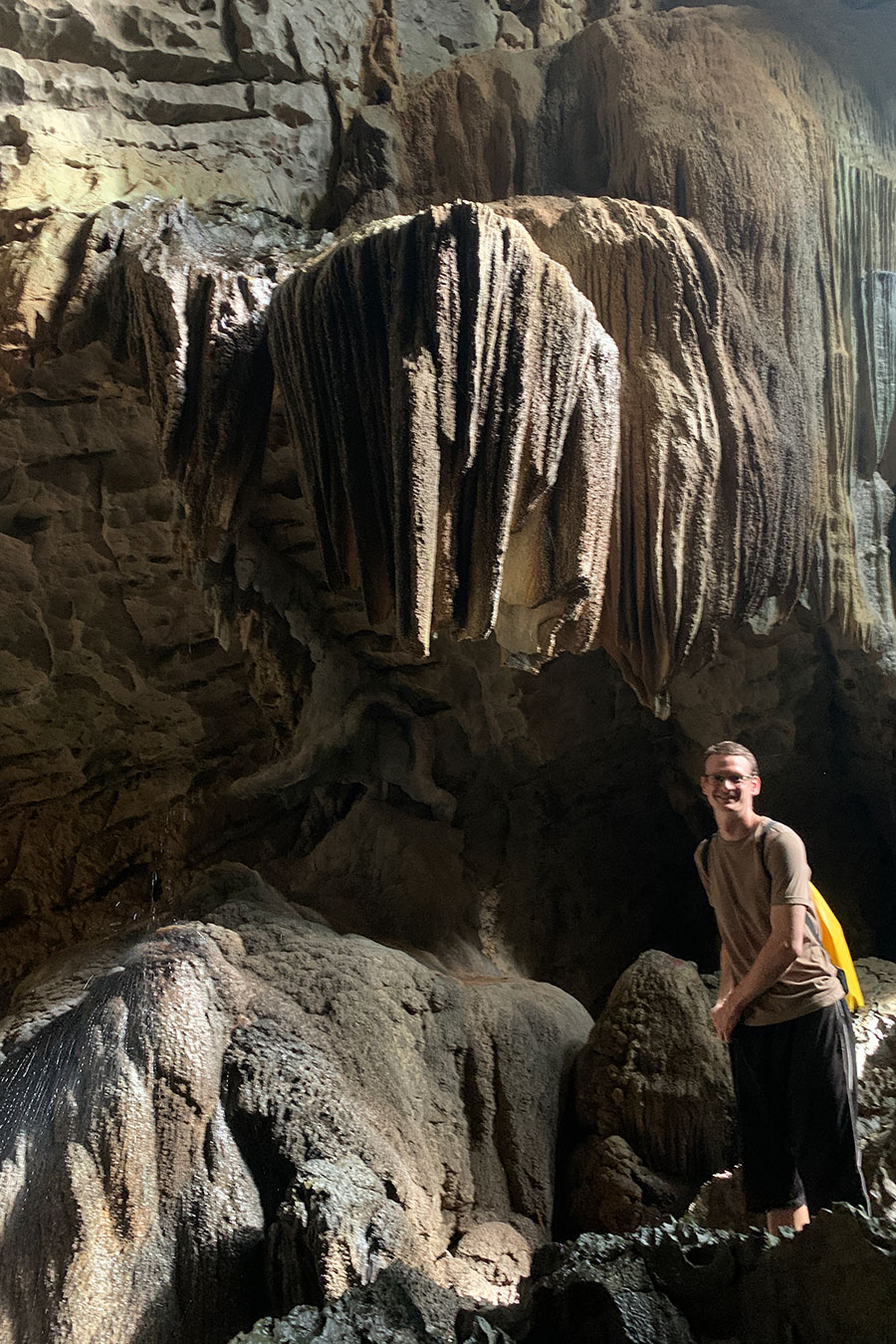
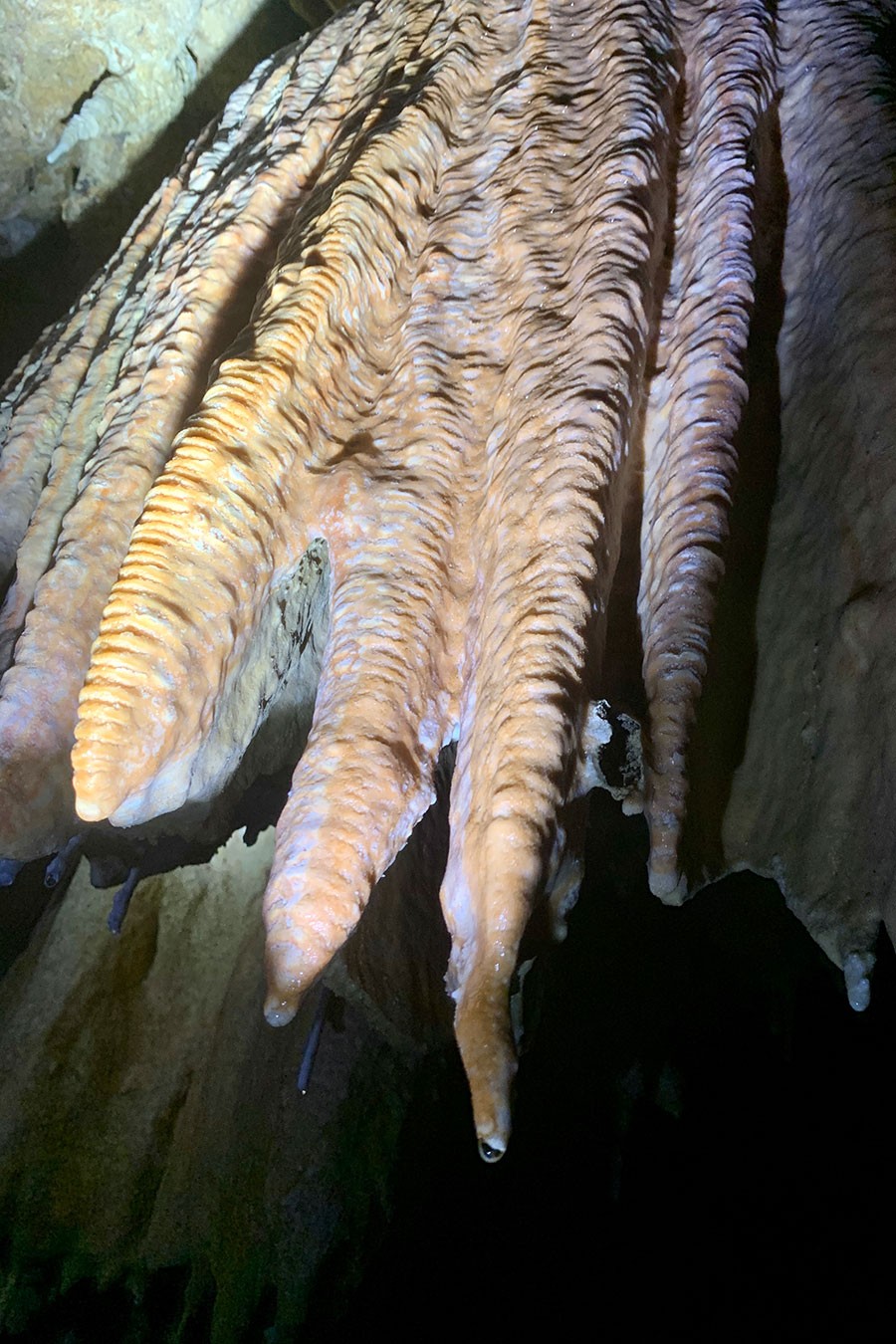
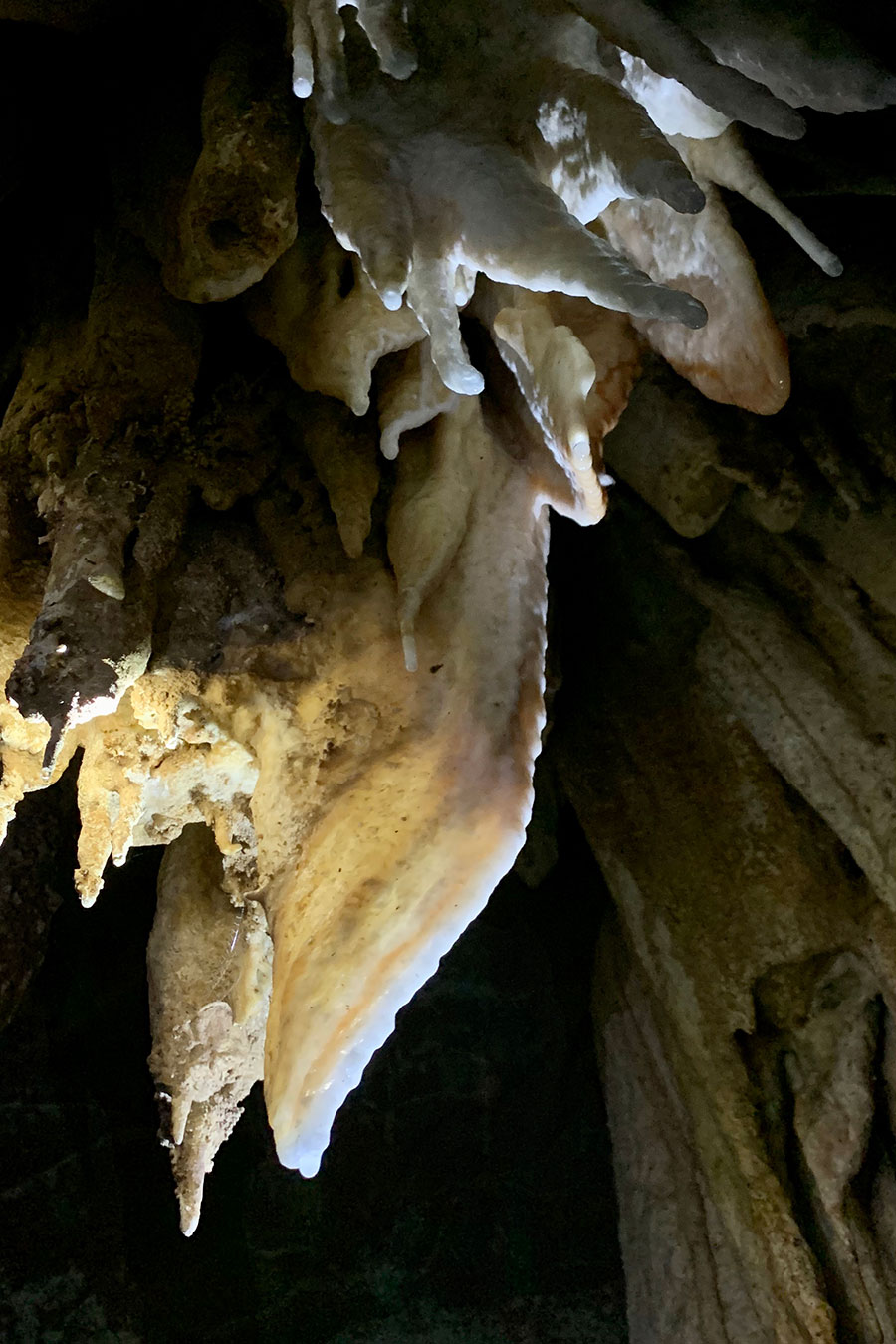
The appearance of the mouth of the cave signals an imminent entrance into another world. I feel an anticipatory tension. We gingerly climb up the muddy rampart into the mouth of the cave, and turn around. We are now inside looking out; the cave frames the jungle and creates a startling view. Jagged karst peaks wreathed in clouds dominate the horizon. The jungle unfolds before us. And all around us is this amazing Khao Sok cave.
Entering the cave
We reach for our headlamps (torches) and move in. The entrance is tight, lots of foot over hand maneuvering. Almost immediately, we encounter calcite formations coating the rocks. Rocks on the path are more evocative of chocolate ice cream than it is of crystallized minerals; in fact, you must use the melted ice cream as hand holds to haul yourself up. And then, just beyond the reach of your hands, a sugary crystalline aspect sparkles and enchants. We have learned an important lesson about the vulnerability of carbonate cave systems. The melted chocolate ice cream formation is in fact the same as the crystalline formation. Human touch, specifically the oils in our hands, tarnishes and dulls the brilliant crystalline expression of calcite, the mineral responsible for the flashy sugary texture.
We continue to maneuver through narrow passageways with the help of our thoughtful guides in addition to broken down rickety stick ladders. We are not really into the cave just yet; our eyes still remember sunlight, our ears still hear birds, our noses still sense jungle air. And look! A cave toad! Or is it just a normal toad, happily chilling out in the cave, looking for food or protection? The toad has normal coloring, it lacks any bizarre appendages, it has eyes that are looking at us. We are not in cave world just yet.
Khao Sok cave – The Crystal Chamber
We push further in, through another tight squeeze. As we wait for the person ahead of us to crawl through the constriction, we hear gasps of amazement. The repeated gasps accompany every person’s entrance. Directly ahead of us is a waterfall in stasis, a crystalline waterfall of sugary gypsum crystals cascading from the shadowy recesses into the center of the room. Long pleated columns known as draperies adorn either side. It looks like the folds of a flowing dress. We are in a wonderland.
The wonderland has its own unique denizens. A cave cricket hops away from the headlamp beam. It has absurdly long front appendages. Perhaps three times as long as the body of the cricket. They are used to sense its light-less world. We do not spot its primary predator, the cave centipede. However, we do come across a Whip Spider, which also preys upon the cricket. It is calmly perched upside down on the ceiling. Evidently it is not hunting for gravity-bound crickets.
Helictites
In this Khao Sok cave Calcite flow formations abound. Some dazzling with shiny reflections, others stained red from iron oxidation, and others tarnished by mud. We see the obligatory stalagmites and stalactites as well, but they are not the show-stoppers here. Rather, unusual formations found on the ceiling are revealed as we walk underneath a low roof that allows our eyes to be just inches from the overhead surface. Tiny white worms of carbonate twist and writhe in all directions from the ceiling. These are helictites. They do not follow the normal vertical logic of water droplets migrating to the tip of a formation and falling to the ground. It is as if the white arms are growing by their own curiosity, probing into the cave’s darkness.
Fossils
We round a corner and come face to face with a solid limestone wall, lacking any flow formation adornments. Yet the flat surface has its own treasures as well. Our lights illuminate strange circular white shapes embedded in the dark grey limestone. Fossils! Truly spectacular examples – complete conical shells six inches long, perfectly sliced through in cross-section, defined by their calcareous sections alternating with limestone.
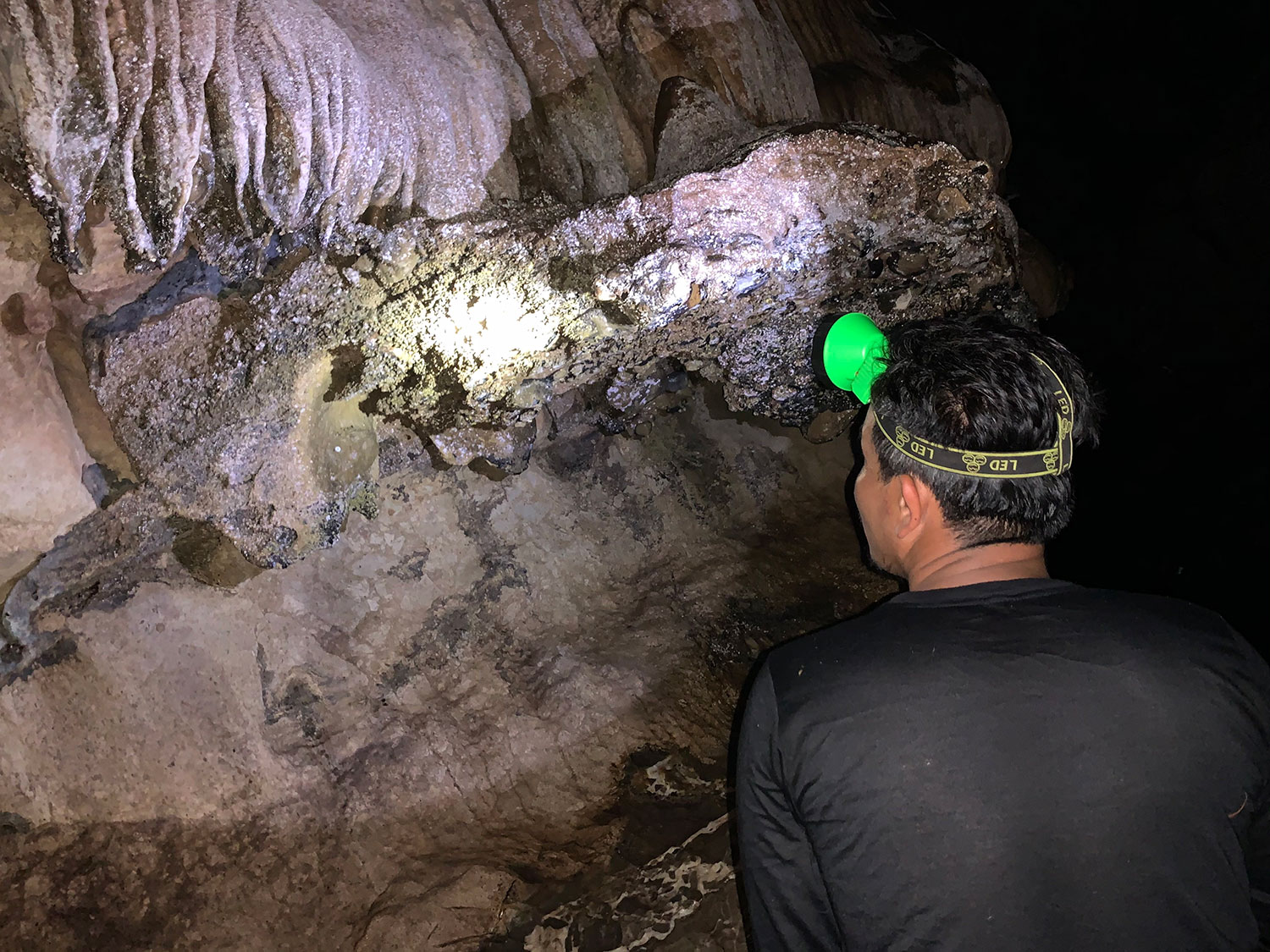
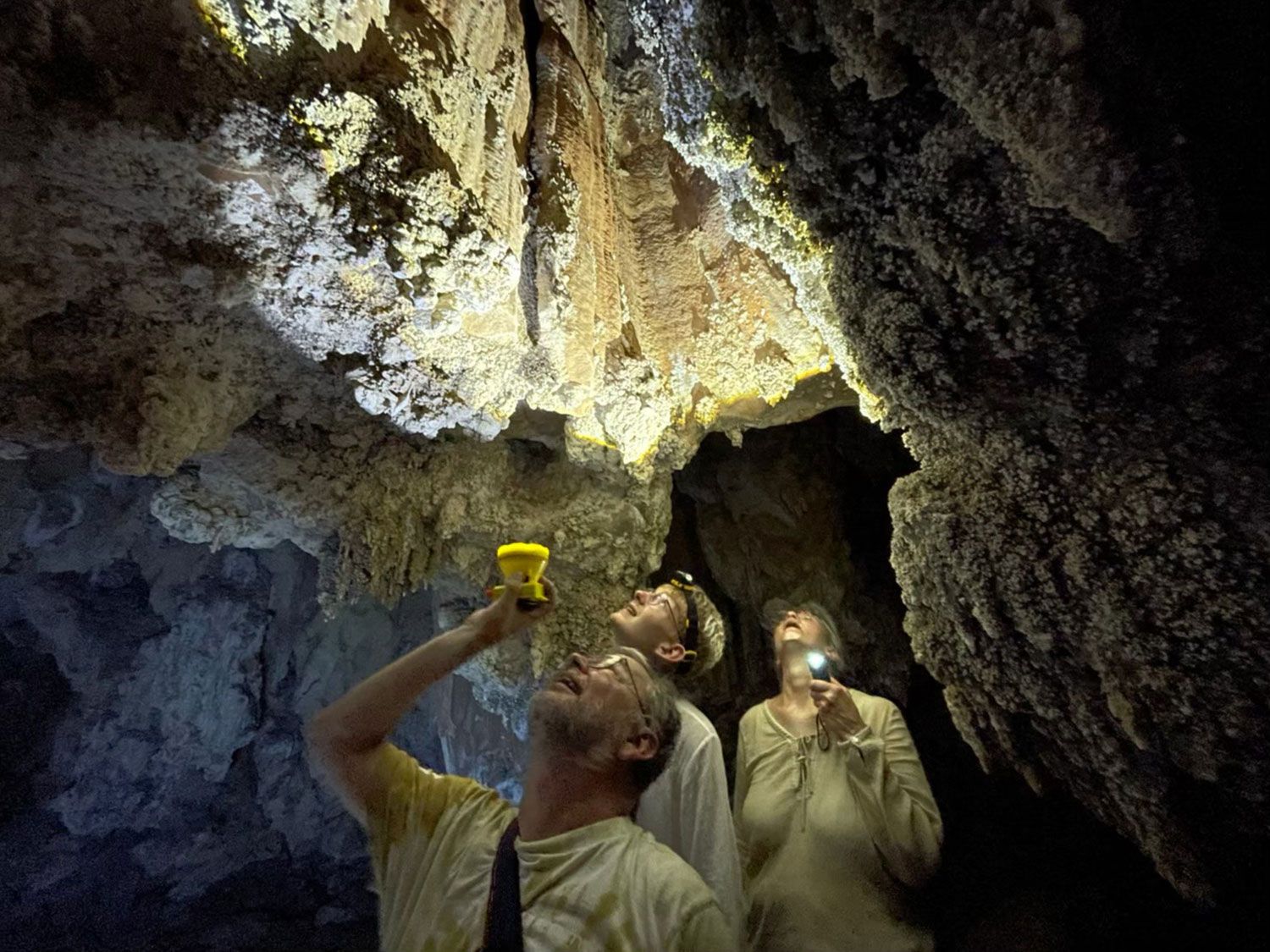
Further into Tam Gaew we press. Eventually we emerge into an enormous room, where our headlamps barely penetrate the darkness of the ceiling. However, the beams are just bright enough to expose the room’s inhabitants: bats! But there are only a dozen of them, hanging from an overhanging rock perhaps 20 feet above us. Our headlamps startle them, and they fly off into the recesses of the cave. As we walk underneath their former roosts, we note drops of guano on the ground. There is something strange; bats roost by the thousands, and have guano piles many feet deep. Are these bats new colonists? Or are they all that remain of a former colony?
Khao Sok cave hike – Heading home
We turn around, and head back for the entrance, walking silently. We have exhausted our “Oooohs” and “Aaaaahs” and are contemplative. The sounds of our feet echoing against the floor dominate. Strangely, some steps resonate more than others. We walk past a sinkhole in the floor, perhaps five feet deep and a couple feet across. Our steps sound as if we are walking across the skin of a drum. It is only a matter of time till another sinkhole opens up. Best to tread lightly in this cave.
Perhaps the best part of any cave exploration is the reemergence into the outside world. The air is fresh and warm and wet with rain, the light is invigorating, and the sounds of the jungle birds are new once again. We happily descend towards the river, but quickly realize that the rain has given our path a treacherous aspect. The ascent was steep and hard on the muscles. The descent is downright dangerous; every step is either a muddy slide or a slick rock. The rope, so unnecessary on the way up, is absolutely critical. We cautiously descend, with everyone taking their turn to slip and fall in the mud.
If you enjoy speleothems (the weird rock structures that grow in caves), check out http://en.wikipedia.org/wiki/Speleothem for more information.
For another Khao Sok cave adventure check out the Bang Man cave hike.

